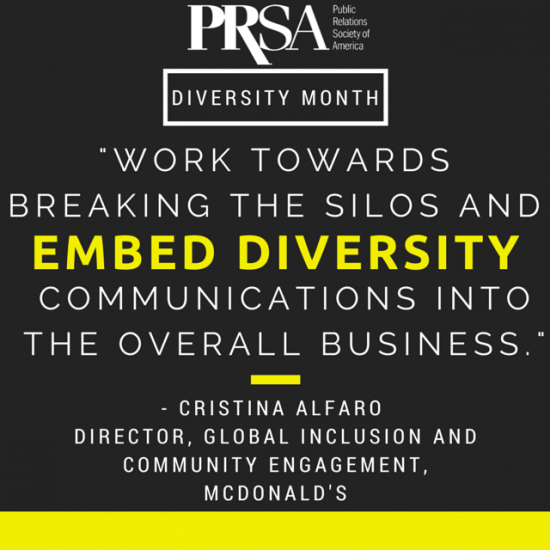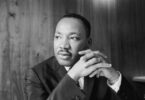Editor’s note: In November, PRSA will celebrate PR Diversity Month by acknowledging the diverse communities, people and practices that encompass the public relations profession and by providing advice and insight on how to build a better PR industry though diversity. We’ve invited PR practitioners and thought leaders from around the country to offer their thoughts on various diversity topics affecting the PR industry. Track the series and join the discussion by using the hashtag #PRDiversity. For a full list of Diversity Month activities visit the 2014 Diversity Month section of the PRSA site.
I’ve been told many times that if you choose to work in diversity communications, you will be pigeon-holed into only getting multicultural assignments, which are low priority, with significantly smaller budgets and offering limited opportunities for advancement. While that may have been true in the past, the pigeon-hole is getting mighty big and it’s going to take many of us to ensure that we are effectively communicating with an ever-growing and widely diverse audience.
My goal with this post isn’t to build the business case for diversity communications, so I’m not going to cite statistics about how many babies will be multi-ethnic by 2050, the astronomical buying power of various consumer segments or how we will define “family” in the future. You can go ahead and google that. There’s plenty of information at your fingertips to validate the business case.
I’d like to instead offer perspective on what I believe are essential competencies of well-rounded diversity communicators. As shocking as it may sound, having an ethnically diverse background does not make you an expert by default. In fact, there are many who, for personal reasons, choose not to embrace their cultural background and don’t have much interest in learning about it or even in being associated with it. On the other hand, I’ve known people that are so passionate about a specific culture, that they know more about its language, food, geography and history than someone that may have been born into it.
So regardless of who you are, I’d like to share three things successful diversity communicators do well:
Develop an Inclusive Mindset: This is not about saying it’s all Kumbaya and claiming to accept all people equally, regardless of race, gender, age, national origin, different ability or sexual orientation…that reads more like a disclaimer. It means having the empathy to put yourself in other peoples’ shoes and aim to truly understand their needs, beliefs and desires. Sounds simple, but it is not. I have personally experienced how some really great people that consider themselves champions of diversity, will draw the line at accepting those that are too different from them. It’s really hard to get past your own biases and embrace differences, but at minimum you must have the willingness to value and respect everyone. That’s how you earn the hearts and minds of your audience, that’s how you get closer to your customers.
Become a Cultural Connoisseur: Don’t be satisfied with just thumbing through studies and reports of demographics and cultural insights that you can include in a communications brief. Become interested in the arts, literature and history of cultures different than your own. Learn a second language. Understand civil rights movements, their origins, leaders and why people continue to fight for equality. Develop a sense for cultural sensitivities. Build a network of subject matter experts that can also serve as advisors and sounding-boards. Learn as many sides of a story as possible, this will help you debunk stereotypes and keep you away from putting people in buckets. It will open your mind to better connect the dots and find creative solutions to your communications challenges.
Declare Yourself a Passionate Change Agent: If you embrace doing this work, it will become part of who you are. Work towards breaking the silos and embed diversity communications into the overall business. Recognize that it’s hard to change mindsets and that people may be intimidated by what they don’t know. Seek out opportunities to benchmark with your peers. The good news is that there are plenty of best practices for you to learn about and share. You’d be surprised how effective you can be in bringing others along.
One of my favorite analogies to explain diversity and inclusion is “Diversity is being invited to the party and inclusion is being asked to dance.” When it comes to diversity communications, I think it’s time to begin leading and showing our moves on the dance floor. Just make sure your moves match the music, don’t do the safety dance while salsa is playing!
Cristina Alfaro is Director of External Diverse Partnerships on McDonald’s Global Inclusion and Community Engagement team at McDonald’s. In this role, she is responsible for identifying, building and maintaining partnerships with key diversity organizations on behalf of McDonald’s. She is charged with developing and executing strategies that create mutually beneficial collaboration opportunities between key stakeholder groups and the brand. She is also the lead for McDonald’s Global Women’s Initiative which includes working as liaison with McDonald’s Women’s Leadership Networks across the globe. She holds a B.A. in Economics from Florida International University and an Associate of Arts from Miami Dade College. She serves as vice president of HPRA’s Chicago Chapter and is on the board of NAACP DuPage County ACT-SO. Cristina is also a recipient of the McDonald’s President’s Award, the highest honor presented to by the corporation to the top one percent of staff employees globally. Follow her on Twitter and connect with her on LinkedIn.








Excellent. This is Cultural Intelligence. Most important than Emotional Intelligence !!!
Diversity, difference and multiculturalism, are a must in the globalization time.
[…] Think “like hires like.” So, as managers, we must make it a priority to foster a culture where speaking up is safe, and get comfortable diversity of thought. After all, diversity is being invited to the party, inclusion is being asked to dance. […]